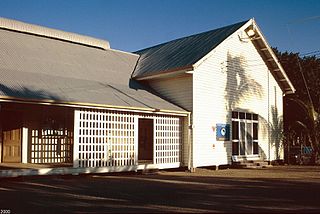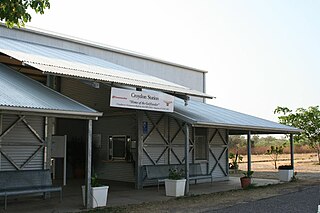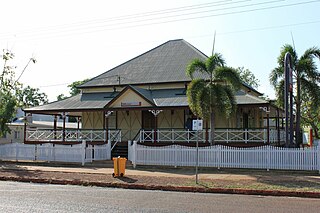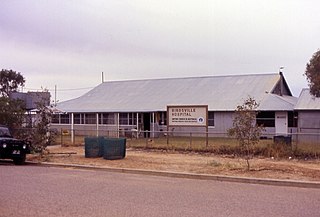
Toowoomba Hospital is a heritage-listed hospital at Pechey Street, Toowoomba, Toowoomba Region, Queensland, Australia. It was built from c. 1880 to c. 1927. It is also known as Toowoomba Base Hospital. It was added to the Queensland Heritage Register on 28 July 2000.

Maryborough railway station is a heritage-listed railway station at Lennox Street, Maryborough, Fraser Coast Region, Queensland, Australia. It is on the North Coast line serving the city of Maryborough. It was designed by Chief Engineer of the Queensland Railways Department and built from 1878 to 1890 by John Roddam & John Walker. It was added to the Queensland Heritage Register on 21 October 1992.

Lonsdale House is a heritage-listed detached house at 283 Boundary Street, Spring Hill, City of Brisbane, Queensland, Australia. It was built from 1860s circa to 1950s circa. It was added to the Queensland Heritage Register on 27 August 1999.

The Bank of New South Wales is a heritage-listed former bank at 242 Mary Street, Gympie, Gympie Region, Queensland, Australia. It was designed by Richard Gailey and built from 1890 to 1891 by T. Kelly. It is also known as Widgee Shire Council Chambers, Coolooa Shire Council Chambers and Gympie Regional Council Chambers. It was added to the Queensland Heritage Register on 15 April 2011.

Maryborough Base Hospital is a heritage-listed hospital at Walker Street, Maryborough, Fraser Coast Region, Queensland, Australia. It was designed by Queensland Colonial Architect John James Clark and built from 1887 by Robert Taylor. It is also known as Maryborough General Hospital. It was added to the Queensland Heritage Register on 2 February 1998.

North Ward Defence Complex is a heritage-listed barracks at 46 Oxley Street, North Ward, City of Townsville, Queensland, Australia. It was built from 1885 to c. 1942. It is also known as 11 Brigade Administration Support Battalion Headquarters Company and Oxley Street Defence site. It was added to the Queensland Heritage Register on 25 August 2006.

Mossman District Hospital is a heritage-listed public hospital at Johnston Road, Mossman, Shire of Douglas, Queensland, Australia. It was designed by Hill & Taylor and built c. 1930 by J J Riley. It was added to the Queensland Heritage Register on 12 June 2009.

Croydon Court House is a heritage-listed former courthouse at Samwell Street, Croydon, Shire of Croydon, Queensland, Australia. It was designed by Colonial Architect's Office and built in 1887. It was added to the Queensland Heritage Register on 21 October 1992.

Croydon Police Station is a heritage-listed former police station at Samwell Street, Croydon, Shire of Croydon, Queensland, Australia. It was built in 1899. It is also known as Former Police Station and Residence. It was added to the Queensland Heritage Register on 23 July 1999.

Croydon Shire Hall is a heritage-listed town hall at Samwell Street, Croydon, Shire of Croydon, Queensland, Australia. It was built c. 1892. It is also known as Croydon Shire Office and Croydon Town Hall. It was added to the Queensland Heritage Register on 11 June 1996.

The Normanton to Croydon railway line is a heritage-listed railway line in the Gulf Country of northern Queensland, Australia. The railway line linking Normanton in the Shire of Carpentaria to Croydon in the Shire of Croydon was built between 1888 and 1891 and is the last isolated line of Queensland Rail still in use. It utilises an innovative system of submersible track with patented steel sleepers and retains buildings of considerable architectural and technical interest at its terminus in Normanton. The only train to operate on the line is the weekly Gulflander service operated by a Gardner diesel propelled railmotor and carriages TP1809 and TP1811.

Croydon railway station is a heritage-listed railway station at Helen Street, Croydon, Shire of Croydon, Queensland, Australia. It was built from c. 1888 to c. 1891. It is on the Normanton to Croydon railway line. It was added to the Queensland Heritage Register on 21 October 1992.

Westpac Bank Building is a heritage-listed bank building at Landsborough Street, Normanton, Shire of Carpentaria, Queensland, Australia. It was designed by Richard Gailey and built in 1886. It is also known as Bank of New South Wales. It was added to the Queensland Heritage Register on 21 October 1992.

Normanton railway station is a heritage-listed railway station at Matilda Street, Normanton, Shire of Carpentaria, Queensland, Australia. It was built in 1889. It was added to the Queensland Heritage Register on 21 October 1992. It serves as a tourist attraction and station for the Gulflander line.

Normanton Gaol is a heritage-listed former prison at 27 Haigh Street, Normanton, Shire of Carpentaria, Queensland, Australia. It was designed by William Taylor Jack and built from 1892 to 1899 by the Department of Public Works. It was added to the Queensland Heritage Register on 23 July 1999.

Burns Philp Building is a heritage-listed former warehouse at the corner of Landsborough Street and Caroline Street, Normanton, Shire of Carpentaria, Queensland, Australia. It was built by Andrew Murphy. It was added to the Queensland Heritage Register on 14 October 2011.

Burketown Post Office is a heritage-listed former post office at Musgrave Street, Burketown, Shire of Burke, Queensland, Australia. It was designed by George Connolly and built in 1887. It is also known as Burketown Tourist Information Centre. It was added to the Queensland Heritage Register on 1 January 1993.

Brick Cottage is a heritage-listed cottage now used as a museum at 8 Simon Street, Gayndah, North Burnett Region, Queensland, Australia. It was built in 1864 by Henry Fenwick. It is now known as Gayndah Museum. It was added to the Queensland Heritage Register on 14 December 2001.

Tambo Post Office is a heritage-listed former post office and now museum at Arthur Street, Tambo, Blackall-Tambo Region, Queensland, Australia. It was built in 1876 and 1885. It is also known as Post and Telegraph Office Tambo and Tambo Telecommunications Museum. It was added to the Queensland Heritage Register on 21 October 1992.

Australian Inland Mission Hospital is a heritage-listed former hospital at Adelaide Street, Birdsville, Shire of Diamantina, Queensland, Australia. It was built from 1952 to 1953 by Ben Hargreaves. It was added to the Queensland Heritage Register on 17 July 2008.

























